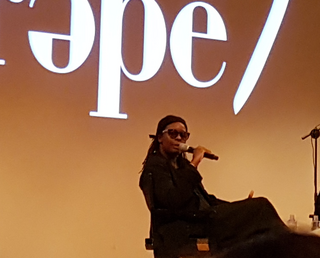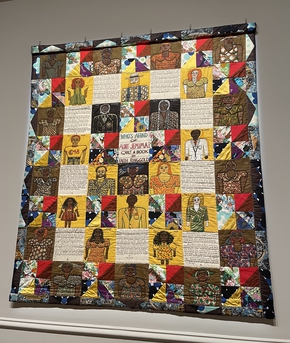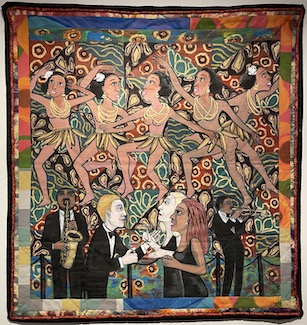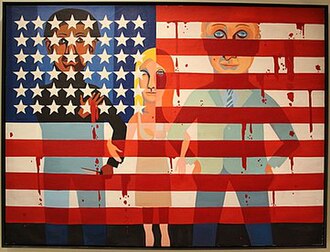
Jasper Johns is an American painter, sculptor, draftsman, and printmaker. Considered a central figure in the development of American postwar art, he has been variously associated with abstract expressionism, Neo-Dada, and pop art movements.

The National Gallery of Art is an art museum in Washington, D.C., United States, located on the National Mall, between 3rd and 9th Streets, at Constitution Avenue NW. Open to the public and free of charge, the museum was privately established in 1937 for the American people by a joint resolution of the United States Congress. Andrew W. Mellon donated a substantial art collection and funds for construction. The core collection includes major works of art donated by Paul Mellon, Ailsa Mellon Bruce, Lessing J. Rosenwald, Samuel Henry Kress, Rush Harrison Kress, Peter Arrell Browne Widener, Joseph E. Widener, and Chester Dale. The Gallery's collection of paintings, drawings, prints, photographs, sculpture, medals, and decorative arts traces the development of Western art from the Middle Ages to the present, including the only painting by Leonardo da Vinci in the Americas and the largest mobile created by Alexander Calder.

Glenn Ligon is an American conceptual artist whose work explores race, language, desire, sexuality, and identity. Based in New York City, Ligon's work often draws on 20th century literature and speech of 20th century cultural figures such as James Baldwin, Zora Neale Hurston, Gertrude Stein, Jean Genet, and Richard Pryor. He is noted as one of the originators of the term Post-Blackness.

African-American art is a broad term describing visual art created by African Americans. The range of art they have created, and are continuing to create, over more than two centuries is as varied as the artists themselves. Some have drawn on cultural traditions in Africa, and other parts of the world, for inspiration. Others have found inspiration in traditional African-American plastic art forms, including basket weaving, pottery, quilting, woodcarving and painting, all of which are sometimes classified as "handicrafts" or "folk art".

Faith Ringgold was an American painter, author, mixed media sculptor, performance artist, and intersectional activist, perhaps best known for her narrative quilts.

Mickalene Thomas is a contemporary African-American visual artist best known as a painter of complex works using rhinestones, acrylic, and enamel. Thomas's collage work is inspired from popular art histories and movements, including Impressionism, Cubism, Dada, the Harlem Renaissance, and selected works by the Afro-British painter Chris Ofili. Her work draws from Western art history, pop art, and visual culture to examine ideas around femininity, beauty, race, sexuality, and gender.

Charles Wilbert White, Jr. was an American artist known for his chronicling of African American related subjects in paintings, drawings, lithographs, and murals. White's lifelong commitment—to chronicling the triumphs and struggles of his community in representational form—cemented him as one of the most well-known artists in African American art history. Following his death in 1979, White's work has been included in the permanent collections of the Art Institute of Chicago, Los Angeles County Museum of Art, The Metropolitan Museum of Art, the Whitney Museum of American Art, the National Gallery of Art, The Newark Museum, and the Santa Barbara Museum of Art. White's best known work is The Contribution of the Negro to American Democracy, a mural at Hampton University. In 2018, the centenary year of his birth, the first major retrospective exhibition of his work was organized by the Art Institute of Chicago and the Museum of Modern Art.
David Hammons is an American artist, best known for his works in and around New York City and Los Angeles during the 1970s and 1980s.
Kerry James Marshall is an American artist and professor, known for his paintings of Black figures. He previously taught painting at the School of Art and Design at the University of Illinois at Chicago. In 2017, Marshall was included on the annual Time 100 list of the most influential people in the world. He was born and raised in Birmingham, Alabama, and moved in childhood to South Central Los Angeles. He has spent much of his career in Chicago, Illinois.
Betty Blayton was an American activist, advocate, artist, arts administrator and educator, and lecturer. As an artist, Blayton was an illustrator, painter, printmaker, and sculptor. She is best known for her works often described as "spiritual abstractions". Blayton was a founding member of the Studio Museum in Harlem and board secretary, co-founder and executive director of Harlem Children's Art Carnival (CAC), and a co-founder of Harlem Textile Works. She was also an advisor, consultant and board member to a variety of other arts and community-based service organizations and programs. Her abstract methods created a space for the viewer to insert themselves into the piece, allowing for self reflection, a central aspect of Blayton's work.
"Where We At" Black Women Artists, Inc. (WWA) was a collective of Black women artists affiliated with the Black Arts Movement of the 1960s and 1970s. It included artists such as Dindga McCannon, Kay Brown, Faith Ringgold, Carol Blank, Jerri Crooks, Charlotte Kâ (Richardson), and Gylbert Coker. Where We At was formed in the spring of 1971, in the wake of an exhibition of the same name organized by 14 Black women artists at the Acts of Art Gallery in Greenwich Village. Themes such as the unity of the Black family, Black female independence and embodiment, Black male-female relationships, contemporary social conditions, and African traditions were central to the work of the WWA artists. The group was intended to serve as a source of empowerment for African-American women, providing a means for them to control their self-representation and to explore issues of Black women's sensibility and aesthetics. Like AfriCobra, a Chicago-based Black Arts group, the WWA was active in fostering art within the African-American community and used it as a tool of awareness and liberation. The group organized workshops in schools, jails and prisons, hospitals, and cultural centers, as well as art classes for youth in their communities.

Dindga McCannon is an African-American artist, fiber artist, muralist, teacher author and illustrator. She co-founded the collective Where We At, Black Women Artists in 1971.
Flora Moore is an American artist associated with the Gee's Bend group of quilters.

The Black Lives Matter street muralin Indianapolis is a large, colorful mural reading "#BLACKLIVESMATTER", with a raised fist, that 18 artists painted across a downtown roadway in August 2020, as part of the George Floyd protests. The mural is located on Indiana Avenue, the historic hub of the city's Black culture, on the same corner as the Madam C. J. Walker Building.

Afro-Atlantic Histories is the title of a touring art exhibition first held jointly at the São Paulo Museum of Art (MASP) and the Instituto Tomie Ohtake in Brazil in 2018. The exhibition was made up of artworks and historical artifacts from and about the African diaspora, specifically focusing "on the 'ebbs and flows' among Africa, Americas, Caribbean and also Europe." Built around the concept of histórias, a Portuguese term that can include fictional and non-fictional narratives, Afro-Atlantic Histories explores the artistic, political, social, and personal impacts and legacies of the Transatlantic slave trade. The exhibition was hailed by critics as a landmark show of diasporic African art.

The American People Series #20: Die is an oil on canvas painting made by American artist Faith Ringgold in 1967. Inspired by Pablo Picasso's painting Guernica (1937) and painted amidst the riots and uprisings of the 1960s, Die is a two-panel work depicting a group of Black and white men, women, and children, most of whom are wounded or covered in blood, variously fighting, fleeing, or dying against an abstract grey background. The piece has been extensively cited as among Ringgold's most important and iconic artworks.

Who's Afraid of Aunt Jemima? is an acrylic on canvas narrative quilt made by American artist Faith Ringgold in 1983. Named for the Edward Albee play Who's Afraid of Virginia Woolf? and the character Aunt Jemima, the work is Ringgold's first story quilt and marks the early stages of the artist's shift from oil painting to quilting.

The French Collection is a series of twelve quilt paintings by American artist Faith Ringgold completed between 1991 and 1997. Divided into two parts composed of eight and four quilts each, the series utilizes Ringgold's distinct style of story quilts to tell the fictional story of a young African American woman in the 1920s, Willia Marie Simone, who leaves Harlem for Paris to live as an artist and model. The stories, illustrated in acrylic paint and written in ink surrounding the paintings, narrate Willia Marie's journey as she befriends famous artists, performers, writers, and activists, runs a café and works as a painter, and develops a distinct Black feminist intellectual worldview based on her experiences and identity. Willia Marie's interactions with notable modernist artists and their oeuvres are an archetypical example of Ringgold's responses to the predominantly white male artistic canon, wherein she often directly invoked, embraced, and challenged the central figures of modernist art.

The American Collection is a series of eleven quilt paintings by American artist Faith Ringgold, completed in 1997, with an additional unfinished quilt that the artist sketched but did not complete. The series serves as a continuation of the narrative the artist began in her earlier series of quilt paintings The French Collection (1991-1997). While the quilts in The French Collection included detailed narratives written in text along the edges of each quilt, The American Collection quilts do not include stories in text and are meant to be understood as paintings by Marlena Simone, the daughter of the fictional central character from the earlier series.














